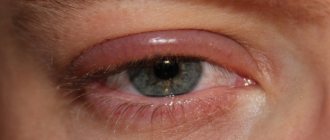Edema or chemosis of the conjunctiva: causes and treatment
Conjunctival chemosis is severe swelling of the mucous membrane of the eye, which protects the organs of vision from adverse environmental factors (dirt, dust, foreign objects).
Also, the function of the conjunctiva is to nourish the tissues of the eyeball to prevent it from drying out. If the protective abilities of the mucous membrane of the eye are impaired for various reasons, then the risk of developing conjunctival chemosis increases. The disease begins with the appearance of swelling, redness, and hemorrhages of the eye shell.
Swelling can reach large sizes, first spreading to the cornea, and then causing the organ of vision to protrude from the palpebral fissure.
Causes
The conjunctival membrane is a layered tissue consisting of a tarsal part, which is tightly adjacent to the eyeball, and a bulbar part, which is not tightly adjacent. Both fabrics are connected to each other by a transitional fold.
There are cavities between the bulbar tissue and the eye, so it rises slightly.
The main inflammatory process when the conjunctiva is damaged occurs in the fold between the tarsal and bulbar tissues, because the healing eye tissues penetrate there poorly and microbes are protected from them.
The main reasons leading to severe swelling of the conjunctiva are:
- use of certain medications;
- swelling of the eyelids;
- barley;
- inflammation of the conjunctiva;
- phlegmon of the eye;
- congestion in the organs of vision;
- excessively dry and dusty climate outdoors or indoors;
- microtrauma of the eye;
- exposure to the mucous membrane of aggressive elements included in cleaning and detergent substances;
- tumors of various types localized in the bulbar region;
- work in a hazardous industry where a person is constantly in contact with harmful chemicals.
If chemosis becomes a consequence of severe forms of conjunctivitis, then purulent discharge and bacterial agents accumulate under the edematous membrane, leading to the formation of ulcers on the cornea. This form of the disease requires long-term and strong treatment.
Chemosis is most often observed in only one eye, but in some cases a bilateral form of the disease is possible, which significantly complicates the treatment process. In this case, a person experiences pronounced painful sensations, and his vision is constantly blurred.
Therapy
To treat conjunctival chemosis, you must consult an ophthalmologist. He will select an individual course of therapy, which includes ointments, tablets, and eye drops. The choice of medications directly depends on the causes of chemosis.
Read in a separate article: Chorioretinitis of the eye: symptoms and treatment
Drug therapy is prescribed depending on the etiology of the disease.
If swelling of the conjunctiva is caused by exposure to allergens, then treatment is carried out with the help of antiallergic and vasoconstrictor drugs (but you must first determine what the person is allergic to and eliminate the allergen). Antihistamines include Tavegil and Claritin.
If conjunctival chemosis develops after blepharoplasty, the treatment is prescribed the same as for the development of the disease as a result of exposure to a viral or bacterial infection.
Antibacterial drugs Okamicin, Gentamicin, Floxal, Tobramycin have a good effect. They work very well when the mucous membrane is damaged by bacteria.
Depending on the degree of damage, various combinations of these drugs in different dosages can be used. Therefore, only a doctor should select medications for the treatment of chemosis of the conjunctival membrane of the eye, as well as develop a regimen for their use!
When is surgery necessary?
In the presence of severe conjunctival chemosis, it is often impossible to cure it only with the help of medications, therefore, to eliminate the pathology, surgical techniques are used, during which the affected eye tissue is excised. Contraindications to surgical intervention are:
- stye on the inside of the eyelid;
- eye tumors;
- abscesses of the eyelid;
- exophthalmos.
In other cases, in the absence of contraindications, the inflamed tissues of the mucous membrane of the eye are removed.
Types of disease
Based on the reasons that contribute to the appearance of chemosis of the ocular membrane, there are several forms of this disease:
Allergic chemosis, as you can understand, can be caused by various allergens. For example, the most common of them are pollen, pet hair, and smoke. Moreover, the inflammatory process can affect both the eyeballs directly and the nearby soft tissues. This reaction is the body’s response to exposure to an allergen, which is manifested by the production of histamines.
Bacterial chemosis of the conjunctiva is caused by harmful bacteria. Increased formation of purulent discharge is a key sign of this pathology.
A viral disease is usually accompanied by a viral infection.
Causes
The main and most common cause of the disease is conjunctivitis.
If the disease develops against the background of conjunctivitis, long-term swelling is observed and intense pain occurs in the eyes.
Dry eyes
In conditions of increased dry air, the risk of developing edema in patients with conjunctivitis increases significantly. Swelling can also form after prolonged exposure to the street in hot, windy weather, or as a result of prolonged work at the computer. Dry eyes are accompanied not only by the formation of conjunctival edema, but also by a feeling of sand and discomfort in the eyes.
Infectious conjunctivitis
Chemosis in conjunctivitis can also be caused by infections. If they penetrate the mucous membranes, pain occurs when moving the eyes, burning, tear production increases, and sometimes pus is present in the tear fluid.
Corneal edema
Another cause of chemosis that occurs against the background of conjunctivitis is inflammation of the cornea due to its damage by viruses, bacteria or fungi. With this pathology, a person is bothered by eye pain, severe swelling, photophobia, and burning. In the morning, after waking up, it is impossible to open the eyelids without rinsing the eyes with warm water. In case of damage to the deep tissues of the cornea, a significant decrease in vision may occur.
Periorbital edema
The development of periorbital edema is caused by damage to the eyes, brain and other organs. Often, after a brain injury, chemosis is localized in the area of the bridge of the nose, since brain injuries cause internal organs to swell and blood flow to be disrupted. One of the distinctive signs of this pathology is the formation of large bruises under the eyes.
Chemosis in allergies
In people prone to allergies, chemosis can develop upon contact with cosmetics, pollen, room dust and other allergenic factors. The pathology is accompanied by swelling and redness of one or both eyes.
Other reasons
Chemosis can also be caused by:
- Barley is a pathology in which a compaction with purulent contents forms on the lower or upper eyelid.
- Blepharitis is characterized by inflammation and redness of the edge of the eyelids in the eyelash area. Blepharitis often occurs due to damage to the sebaceous glands by mites.
- Eyelid abscess - this pathology is characterized by the development of infiltrative purulent inflammation.
- Orbital phlegmon is a condition in which a purulent-inflammatory process occurs in the orbital retina.
- Burns to the mucous membranes of the eyes can occur due to exposure to UV rays or any chemical substance.
- Entry of a foreign body, injury to the eye.
In addition, chemosis can develop due to any pathological process in the body. So, often the disease occurs against the background of:
- endocrine diseases;
- brain inflammation;
- tumor processes;
- exophthalmos (pathological displacement of the eyeball);
- vascular diseases, stagnation of blood in the veins;
- skin tuberculosis.
If chemosis occurs as a result of the listed pathologies, the disease is characterized by a long course, and local treatment does not give a positive result.
Symptoms
Remember! In the first days of the onset of chemosis, it is impossible to establish the disease, since the purulent accumulations between the eye and the conjunctival membrane are not so significant and the inflammatory process does not manifest itself very clearly.
But over time, the pathology makes itself felt with such signs as:
- a feeling of burning, itching and stinging in the eyes;
- copious purulent discharge from the organs of vision affected by the disease;
- swelling spreads from the conjunctiva to the eyelids, the closure of which can cause severe pain;
- the appearance of a veil or fog before the eyes.
In all cases, a person with chemosis has a sharp drop in visual acuity, but such processes are reversible if treatment is started in time.
Otherwise, destructive processes begin to develop in the eye tissues themselves, in which vision may subsequently not be restored or may return only partially.
Should hyposphagma be treated?
The vast majority of hyposphagmas regress on their own within a few days (the bloody spot may persist for up to 2-3 weeks) and do not require any treatment. However, in some situations, etiotropic therapy may be required aimed at eliminating the cause of hemorrhage, especially if it occurred against the background of impaired hemostasis.
According to individual indications, the following drugs can be prescribed for complex and supportive treatment of subconjunctival hemorrhage:
- Antibacterial agents in the form of drops (Tobrex, Levofloxacin). Antibiotic therapy is necessary only in case of a complicated course due to secondary infection of the damaged surface and its suppuration.
- Artificial tear preparations (Vizin, Systane). Artificial tear preparations for subconjunctival hemorrhage are prescribed as part of tear replacement therapy to maintain normal levels of eye moisture and stimulate cellular healing. They contain water, polysaccharides, salts and polymers that stabilize and thicken the precorneal tear film, accelerating the resorption of the hyposphagma. Instillations can be done up to 4-6 times a day.
- Angioprotectors and vasodilators (Pentoxifylline, Vincamine, Diosmin). Drugs with angioprotective effects improve blood microcirculation, strengthen the walls of eye vessels, and reduce their fragility. They also have a positive effect on the rheological properties of blood, which prevents its stagnation.
Therapy must be supplemented with vitamin complexes and vitamin-mineral supplements with a sufficient content of components necessary to maintain the normal functioning of the visual system and the functional state of the capillaries. These are, first of all, vitamins C, A, E, group B vitamins, zinc, chromium and lutein. For recurrent hemorrhages, increased doses of ascorbic acid and rutin (vitamin P) are used.
Patients with high blood pressure require additional cardiac monitoring and adequate antihypertensive correction.
Treatment options
Medicines
Important! First of all, when diagnosing chemosis, the patient is prescribed conservative drug therapy, which involves the use of different drugs depending on the etiology of the disease:
- When chemosis develops against the background of allergic reactions, antihistamines and vasoconstrictors can be used, but they will be effective only if contact of the conjunctiva with allergens is previously excluded.
- If the disease develops due to a viral infection, the use of antiviral drugs acyclovir, interferon, poludan or indoxuridine is appropriate. The maximum effectiveness of these drugs appears on the first day of treatment.
- Antibiotics (floxal, okamicin, tobramycin, gentamicin). These remedies are relevant in case of damage to the mucous membrane by bacterial pathogens. Depending on the severity of the pathology and the pathogen, different combinations of such drugs in different dosages can be used.
Surgical methods
Severe and moderate degrees of chemosis sometimes cannot be treated solely with medications, so there is a need for surgical intervention.
Keep in mind! Indications for such operations may include pathologies developing against the background of the underlying lesion:
- abscess of the eyelid,
- orbital tumors,
- the appearance of stye on the inside of the eyelid,
- exophthalmos.
In such cases, the affected tissue is excised and removed.
Folk remedies
Medicinal methods can also be combined with traditional methods of treatment, among which the most effective may be:
- Lotions based on marshmallow roots. In 200 grams of boiled (but not hot) water, infuse 3 tablespoons of the plant for 8 hours. Soak gauze or cotton swabs in the finished product and apply them 3-4 times a day to the sore eye.
- A teaspoon of any honey is diluted in 0.5 liters of bottled or boiled water. Such drops are instilled twice a day, one drop into each eye.
- Two teaspoons of dried rose hips are boiled in 200 grams of water for five minutes and left to cool for 30 minutes. The product is used three times a day as a lotion.
- Pour a glass of boiling water over a tablespoon of dried chamomile and bring to a boil in a water bath. Soak a cloth or gauze in the cooled product 3-5 times a day and apply it to the affected organs of vision for 5-7 minutes.
It is worth noting! Chemosis is not recommended to be treated exclusively with traditional methods, as this is a serious disease that often requires the development of an individual treatment regimen.
But in agreement with the attending physician, such methods can be used as additional ones.
What diseases cause swelling of the eyes?
Eyes become swollen due to simple lack of sleep, overwork, and consumption of alcoholic beverages. People who eat too salty, fatty and other unhealthy foods before going to bed wake up in the morning with swelling and bruises under their eyes.
Also, the causes of this symptom may be:
- allergic reactions;
- infectious and inflammatory eye diseases;
- pathologies of the thyroid gland, pituitary gland, heart, blood vessels, digestive organs;
- disruption of lymph flow;
- eye and face injuries.
When they talk about swelling on the face, they mean bags or circles under the eyes, swelling of the lower and upper eyelids, and other structures of the eyeball, for example, the conjunctiva, which happens with conjunctivitis. In other words, there are many reasons for these symptoms. These can be both pathological and non-pathological conditions, eye diseases and systemic pathologies. Moreover, the nature of swelling with conjunctivitis may vary depending on the type of inflammatory process. All this suggests that the first thing you should do is not always try to get rid of the symptom. It is better to first determine its cause. Let's take a closer look at diseases associated with inflammation of the conjunctiva, find out how they are treated, and how eye swelling can be quickly eliminated.
Therapy
The method of therapy is selected depending on what specific factor caused the disease. Moderate and mild degrees of chemosis are treated at home, using medications and traditional medicine. In severe situations requiring surgical intervention, the patient is hospitalized and then undergoes surgery.
Drug treatment
Antibiotics, antivirals, antihistamines or vasoconstrictors are used as conservative agents:
- Antibiotics - eye drops containing antibacterial components are most often used - Oksamycin, Gentamicin, Tobrex, Floxal. If necessary, as a supplement to the drops, the doctor may prescribe antibiotic tablets.
- Antiviral - used if the disease was caused by viruses. Poludan, Indoxuridine, Acyclovir are used as such drugs.
- Antihistamine and vasoconstrictor drops help eliminate symptoms that occur due to allergies.
Surgical
The operation is prescribed if chemosis was caused by a tumor process in the eye, internal barley, or an abscess of the eyelid. In addition, surgery may be required for exophthalmos and other pathologies.
ethnoscience
Traditional recipes can only be used as an adjunct to drug treatment.
Among folk remedies, the most effective are:
- Eye lotions made from marshmallow roots. An infusion is prepared from the roots of this plant (200 ml of water and 3 tablespoons of crushed raw materials), cotton pads are soaked in the resulting mixture and applied to the eye sockets.
- Lotions from rosehip decoction prepared from 200 ml of water and 2 teaspoons of chopped berries. After boiling for 5 minutes, the broth must be left for 30 minutes and then strained.
- Honey-based eye drops - prepared from 300 ml of water and 1 teaspoon of natural honey. Fresh drops must be prepared every day. When diluting honey in water, do not use boiling water.
- Fresh cherry juice - used both for washing the eyes and as a lotion for the eye sockets. It is also useful for patients with chemosis to consume at least a glass of cherries daily.
- Lotions made from chamomile infusion. The infusion is prepared from 200 ml of water and 1 tbsp. spoons of plant flowers.
Chemosis in allergies
Common causes of conjunctival swelling are various allergic reactions. In these cases, chemosis develops quite quickly, sometimes severe inflammation, which prevents you from closing your eyes, occurs literally in minutes. At the same time, it can subside just as quickly - it is enough for a person to take an antihistamine or eliminate contact with the allergen.
The most dangerous thing about this kind of swelling is that the eye begins to itch very much, and a person can damage the inflamed cornea. And the injury will lead to other complications, in particular, infection.
Swelling of the eye occurs both in contact allergies (when a substance gets directly into the eye) and among other symptoms in a general allergic reaction. In the second case, chemosis necessarily affects both eyes, and the person also experiences:
- Severe lacrimation.
- Allergic rhinitis.
- Sneezing.
Swelling of the mucous membranes of the respiratory tract, sometimes with noticeable difficulty breathing. These symptoms can lead to:
- Plant pollen.
- Dust.
- Household chemicals.
- Washing powder.
- Animal fur.
- Food.
- Perfumery.
Contact allergies may only affect one eye. Among the allergens that cause a local reaction, the most common are medications (eye drops and gels) and cosmetics.
Possible complications
If chemosis is not eliminated in time, inflammatory and edematous processes can spread to the cornea.
This in turn will lead to keratitis (inflammation of the cornea), but unlike the more “hardy” conjunctival tissue, which is also capable of regenerating, the cornea does not have reliable external protection and regeneration mechanisms.
As a result, advanced chemosis can lead to complete or severe, but irreversible loss of vision .
How to relieve swelling from the eyes with chlamydial conjunctivitis?
Chlamydia can remain in the human body for a long time without manifesting itself. As soon as you catch a little cold, the first signs of the disease appear. Chlamydial conjunctivitis is usually contracted in swimming pools and saunas. Inflammation usually develops in both eyes at once. It is characterized by the following symptoms:
- swelling of the eyelids;
- eyelashes sticking together in the morning;
- copious purulent discharge;
- hyperemia of the connective membrane;
- photosensitivity;
- lacrimation;
- an increase in the size of the lymph nodes.
The eyelids swell with acute conjunctivitis. If it becomes chronic, many symptoms disappear or become mild. The disease is treated with antiviral and antibacterial drugs. In addition, immunomodulators are prescribed to strengthen the immune system. You can quickly relieve symptoms of this type of conjunctivitis using eye drops based on natural tears.
They help eliminate redness and swelling. However, such drugs do not fight the pathogen itself, so relieving symptoms in this way without using antiviral drops can lead to a chronic form of inflammation.
Signs of chemosis
The most important symptom that a patient experiencing chemosis will observe is swelling of the conjunctiva. Usually it is expressed quite strongly, and it is unlikely to be confused with something else. This is an acute condition that any doctor will identify after examining the patient, even without the use of instrumental examination methods.
Sometimes chemosis is not immediately noticeable to the patient himself (as a rule, if we are talking about the initial stages of the development of the pathology). It will not even bother the patient, and the presence of developing inflammation will only be revealed by a doctor during an eye examination (for example, at a preventive appointment).
Chemosis usually develops only on part of the conjunctiva, and not on its entire surface. The so-called bulbar zone, located on the eyeball, is most susceptible to it. If the case is advanced, then the disease can affect the entire conjunctiva, as well as affect the mucous membranes on the eyelids, and in both eyes.
With chemosis, the patient may notice the following signs:
- change in the color of the sclera - they become yellow, covered with clearly visible burst vessels;
- difficulty blinking and closing eyelids;
- lacrimation;
- protrusion of the conjunctiva;
- pain, burning and stinging in the eyes.
All pathological processes with chemosis are reversible, it is only important to consult a doctor in time and begin treatment, and not try to independently eliminate only the symptoms, attributing them to allergies or eye fatigue. Without treatment, your eye condition will get worse and worse every day.
Next, a bacterial infection may develop - one of the most dangerous complications of the pathology. Here, suppuration is added to the symptoms listed above, the pain becomes stronger, vision gradually becomes worse - the patient seems to have a veil before his eyes. In the light, a person experiences serious discomfort, that is, photophobia develops.
Without treatment, your eye condition will get worse and worse every day. Next, a bacterial infection may develop - one of the most dangerous complications of the pathology. Here, suppuration is added to the symptoms listed above, the pain becomes stronger, vision gradually becomes worse - the patient seems to have a veil before his eyes. In the light, a person experiences serious discomfort, that is, photophobia develops.
Depending on the cause of the swelling, there are several types of chemosis. They will require different treatment.
Types of chemosis
Diagnostics
First of all, when the first minor manifestations appear, you should seek advice from a specialist. Before starting treatment, the doctor will conduct an examination, establish a diagnosis and determine the cause of the development of the pathology. Mandatory diagnostic methods are:
- tonometry;
- determination of intraocular pressure indicators;
- blood collection for general analysis;
- bacteriological scraping made from the mucous membrane of the affected eye;
- ophthalmoscopy;
- conducting an examination of the fundus of the eye to assess the cell structure;
- ultrasound examination;
- radiography;
- biomicroscopy;
- analysis of the anterior and posterior sections of the eye.
At the same time, the patient is excluded from the presence of diseases such as tuberculosis, the presence of benign or malignant formations. Conjunctival chemosis can affect people regardless of age, but is most common in adults. Pathology in childhood is extremely difficult to tolerate, since it is associated with infection.
Is it possible to prevent chemosis?
In some cases, such as after eye surgery, chemosis cannot be prevented. However, if chemosis is caused by allergies, taking steps to eliminate them and manage symptoms can reduce the risk of recurrent attacks of chemosis. Practice good hand washing to prevent the spread of bacteria. Also avoid excessively touching or rubbing your eyes, especially with dirty hands.
Risk group
People at risk are those who:
- use medications without consulting a specialist;
- suffer from swelling of the eyelid, which can provoke chemosis of the conjunctival tissues;
- often suffer from the development of stye;
- have inflammation of the conjunctival membrane;
- suffer from household allergies to wool, odors, dust, etc.;
- have phlegmon of the eyes;
- suffer from congestive processes in the eyes;
- do not tolerate dry air and dust indoors or outdoors;
- have eye injuries of varying complexity;
- expose mucous membranes to chemical components of cleaning agents and detergents;
- have tumors in the bulbar region of various types;
- perform work in hazardous conditions.
Prevention
There are rules to help prevent eye chemosis or at least minimize the risk of its development. It is important to follow these tips:
- Protect your eyes from dust, small debris and foreign objects.
- Protect your eyes from open sunlight. When going outside, you need to wear sunglasses.
- Avoid excessive eye strain.
- You should reduce the time spent in front of the computer and TV. Periodically you need to take breaks and exercise your eyes. The duration of the break must be at least 5 minutes.
- It is necessary to get full sleep. During night sleep, the conjunctival membrane is regenerated. Night restoration promotes normal and complete eye protection throughout the day.
- It is important to ensure proper nutrition. For the eyes you need dark chocolate, blueberries, carrots and onions.
- You should periodically take preventive measures for the body by taking a complex of vitamins and minerals.
- Be regularly examined by an ophthalmologist.
Traditional methods
There are also a number of methods for treating chemosis with folk remedies. It seems that in order to use them, you don’t even need to go to the doctor... True, few people realize that if herbs and lotions are used incorrectly, there is an error in diagnosis, or due to individual intolerance to the components, such treatment methods can be dangerous not only for health, but sometimes also for life. So, before you use one of the methods below, you should definitely visit a doctor and consult about this treatment option.
Among the traditional methods against chemosis, the following options have proven themselves well:
- Marshmallow root, from which a solution for lotions is made. To do this, you need to infuse 3 tbsp in 1 glass of boiled water at room temperature. l. marshmallow root. Let the mixture sit for about 8 hours. Then you need to soak a sterile napkin in the solution and simply apply it to the sore eye about 3-4 times a day.
- Honey. Dilute it in the amount of 1 tsp. in half a liter of boiled water. You will get folk eye drops. You need to instill them 1 drop at a time.
- Pharmaceutical camomile. A decoction is prepared from it: 1 tbsp. l. chamomile pour 1 tbsp. boiling water and boil in a water bath. Then the solution is cooled, pieces of gauze are soaked in it, applied to the eyes up to 5 times a day and kept for 6-7 minutes each time.
- Rosehip - its berries need to be boiled in an amount of 2 tsp. for 1 tbsp. water for 5 minutes and then let sit for about half an hour. The product is used, like other herbal home remedies, as lotions.
- Cherries also help well, which are recommended to be eaten, as well as to drop their juice, diluted with water, into the eyes or make lotions based on it.
Chamomile is a good helper and an excellent natural antiseptic.
Traditional medicine helps best in the early stages of pathology. With a complex form of chemosis, it will be completely ineffective and can even worsen the condition of the eyes.











